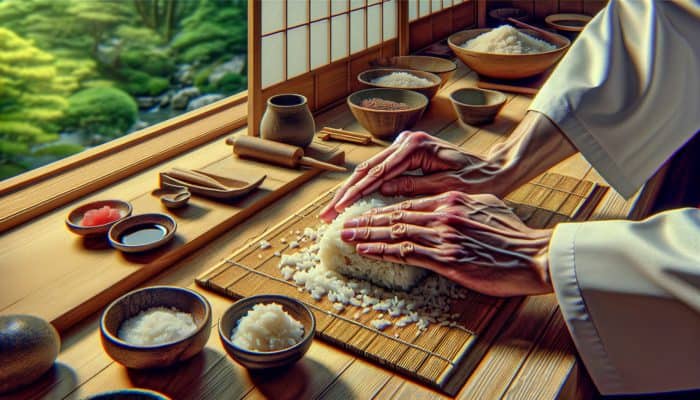Must-Have Tools for Mastering the Art of Sushi Rolling
How to Select the Perfect Sushi Rolling Mat for Achieving Flawless Rolls

A top-notch bamboo sushi mat is an indispensable tool for anyone eager to refine their sushi rolling skills. The flexibility and control provided by a well-crafted mat are crucial for achieving tightly rolled sushi that is both visually appealing and delicious. When choosing a mat, assess its thickness and overall quality of craftsmanship; a thicker mat typically offers enhanced stability, while a thinner mat may be better suited for creating intricate and delicate sushi shapes. After every use, it's vital to clean and dry your mat thoroughly; any leftover rice or moisture can lead to bacterial growth, jeopardizing food safety and quality.
Investing in a premium sushi rolling mat not only elevates your rolling technique but also brings a sense of joy to the sushi-making process. With the right mat in hand, you can experiment with a variety of sushi styles, from classic maki to the more advanced uramaki. As you hone your skills, you'll find yourself rolling sushi like a professional chef, unlocking a culinary world that enables you to impress friends and family with your newfound expertise and creativity.
The Critical Role of a Sharp Knife in Sushi Crafting
A sharp knife is often overlooked, yet it plays a pivotal role in the sushi-making process, significantly affecting both the presentation and texture of your culinary creations. A dull knife can crush the rice and fillings instead of slicing through them seamlessly, resulting in ragged edges and an unappealing appearance. For optimal results, consider utilizing a traditional sushi knife known as a yanagiba, which is especially designed for precise slicing of fish and other ingredients with ease.
Proper maintenance and care of your knife are equally important to ensure it performs at its best. Regular honing and sharpening keep your knife in excellent working condition. Moreover, your cutting technique matters; aim for a smooth, swift motion rather than a sawing action, as this preserves the integrity of each slice. This meticulous attention to detail can elevate your sushi from merely adequate to truly exceptional, enhancing both its flavor and visual appeal for an unforgettable dining experience.
Essential Tools for Preparing Perfect Sushi Rice: Rice Paddle and Bowl
Managing sushi rice can become quite a challenge without the appropriate tools. A non-stick rice paddle, combined with the right bowl, simplifies this crucial task significantly. Utilizing a rice paddle helps to prevent the rice from clumping together, allowing for even distribution across your nori. Look for paddles crafted from materials like wood or silicone, as they are gentler on the rice, aiding in achieving the ideal texture necessary for sushi.
When selecting a bowl, opt for one that is wide and shallow, as this design promotes effective cooling and seasoning of the rice. Such a bowl allows for easy access when incorporating vinegar, sugar, and salt into the rice. Efficient handling of sushi rice is crucial for achieving that perfect sticky consistency, making the right tools indispensable for anyone serious about mastering how to roll sushi like an expert.
Mastering the Techniques for Perfect Sushi Rice Preparation

Choosing the Right Rice for Sushi: Expert Tips and Tricks
The foundation of any exceptional sushi is its rice; thus, selecting the correct type is vital for success. Short-grain sushi rice, commonly referred to as Japonica, is optimal due to its unique sticky texture, which allows it to hold together perfectly during the rolling process. This type of rice can typically be found in Asian supermarkets worldwide and is essential for crafting an authentic sushi experience that delights the palate.
When shopping for sushi rice, seek out brands specifically labeled for sushi-making. The quality can vary significantly, directly affecting both flavor and texture. Always check for freshness; rice that has been stored for long periods may not yield the best results. By investing in high-quality sushi rice, you lay the groundwork for success, ensuring that your rolls not only taste exceptional but also retain their structure throughout the rolling process, creating a delightful culinary experience.
Key Cooking Techniques for Perfect Sushi Rice Every Time
Mastering the cooking of sushi rice requires a precise understanding of the water-to-rice ratio and cooking time. Generally, the recommended ratio is approximately 1:1.2, which means that for every cup of rice, you should use 1.2 cups of water. It is essential to rinse the rice thoroughly before cooking to remove excess starch, which can lead to a gummy texture that is undesirable in sushi preparation. This rinsing step is crucial for achieving the perfect consistency that sushi rice is renowned for.
After rinsing, soak the rice for at least 30 minutes to allow it to absorb some water prior to cooking. For optimal results, consider using a rice cooker, as it provides consistent temperature and timing—both critical for achieving perfectly cooked sushi rice. After cooking, let the rice sit covered for about 10 minutes to finish steaming. This additional step ensures your sushi rice achieves the desired flavor and consistency, making it significantly easier to work with during the rolling process.
Enhancing the Flavor of Sushi Rice with Delicious Seasoning

Seasoning is where sushi rice truly transforms, turning plain rice into a flavorful base for your sushi creations. A traditional mixture of rice vinegar, sugar, and salt is typically used to achieve this enhancement. While the proportions can vary, a common starting point is 1/4 cup of rice vinegar, 2 tablespoons of sugar, and 1 teaspoon of salt for every 2 cups of cooked rice, yielding a balanced flavor that beautifully complements the sushi.
To prepare the seasoning, gently heat the mixture until the sugar dissolves, then carefully fold it into the rice using a wooden paddle. Be gentle during this process to avoid crushing the grains, as this could compromise the texture. Once mixed, allow the rice to cool to room temperature for optimal results. Properly seasoned rice not only enhances the overall taste of your sushi but also elevates the dining experience, transforming each bite into a delightful journey into the world of sushi flavors.
Choosing Quality Ingredients for Crafting Exceptional Sushi
How to Select Fresh Fish and Seafood for Sushi Preparation
Choosing high-quality fish and seafood is essential for creating delicious sushi. Freshness is of utmost importance, as sushi relies heavily on the natural flavors of its ingredients. Look for fish that displays bright, vibrant colors and emits a clean, oceanic aroma. In many areas, fish markets and specialty seafood stores offer the best selections, often featuring local catches that represent the unique culinary landscape of the region.
Popular seafood choices for sushi include salmon, tuna, and eel, but don't overlook regional options that can provide unique tastes and experiences. For instance, in coastal regions of Japan, fresh uni (sea urchin) or octopus may be available for sushi preparation. When choosing seafood, always consider sustainability and opt for suppliers who practice responsible fishing methods, ensuring that you support sustainable fisheries while enjoying high-quality ingredients that enhance your sushi creations.
Safety is another critical factor to keep in mind. If you're new to sushi-making, it's advisable to consult professionals or educational resources about safe handling and preparation techniques, especially when working with raw fish. With the right ingredients and knowledge, you can elevate your sushi-making skills, impressing everyone with your exquisite culinary creations that reflect your dedication to quality.
Diverse Vegetables and Fillings to Enhance Your Sushi Rolls
Incorporating a variety of vegetables and fillings can significantly elevate the flavors and textures within your sushi rolls. Common choices include cucumber, avocado, and carrot, but don’t hesitate to experiment with seasonal produce or local favorites that inspire your creativity. For example, in certain parts of Southeast Asia, fresh herbs like mint or coriander could provide delightful additions to your sushi rolls, introducing freshness and complexity to the flavor profile.
It’s crucial to prepare your fillings correctly—slice the vegetables thinly to guarantee they roll easily and evenly within the nori. Pay attention to the balance of flavors; for instance, pairing creamy avocado with crunchy cucumber creates a delightful contrast in each bite. The beauty of sushi lies in its versatility, allowing you to craft unique combinations that reflect your personal taste and preferences, making each roll a true expression of your culinary artistry and creativity.
Understanding Nori Quality for Optimal Sushi Wrapping
The quality of nori, the seaweed utilized for wrapping sushi, significantly impacts the overall quality and taste of the final product. High-quality nori is characterized by a dark green hue, a glossy appearance, and a crisp texture when touched. When purchasing nori, seek brands that are highly recommended or well-reviewed by sushi enthusiasts to ensure you select the best quality available.
Ideally, nori should be toasted, as this enhances its flavor and texture, making it easier to manage during the rolling process. To assess the quality of nori, consider how it holds together when wet; good nori will remain intact without becoming overly soggy during rolling. Choosing the right nori can elevate your sushi, adding both flavor and visual appeal to your culinary creations, making every bite an exquisite experience that delights the senses.
Fundamental Techniques for Beginners to Perfect Sushi Rolling
Mastering Hand Positioning for Consistent and Uniform Sushi Rolls
Proper hand positioning is essential for achieving uniform and tightly rolled sushi pieces. Begin by placing your hands on either side of the bamboo mat, gripping the edges with your fingers while your thumbs apply gentle pressure to the top of the nori. This specific positioning allows for even pressure distribution as you roll, ensuring that the sushi maintains its shape and does not fall apart, resulting in a beautifully crafted roll.
Practice is key; don’t be discouraged if your initial rolls aren’t perfect. As you gain experience, you’ll develop a keen sense of the ideal amount of pressure to apply. It's essential to keep your hands clean and slightly damp, as this helps prevent the rice from sticking to your fingers. With consistent practice, your hand positioning will become second nature, leading to flawless sushi rolls that showcase your growing skills and confidence in the kitchen.
Finding the Right Tightness for Perfectly Rolled Sushi
Achieving the right rolling tightness is a skill that sets amateur sushi makers apart from seasoned professionals. If your roll is too loose, the ingredients may spill out; conversely, if it’s too tight, the roll may tear or become unappetizingly compressed. Begin by gently tucking the edge of the mat over the filling, using your fingers to guide the ingredients into the roll with care and precision.
As you roll, apply consistent, gentle pressure to keep everything snug without compromising the integrity of the ingredients. The ultimate goal is to create a tight roll that holds together beautifully without being overly compressed. If necessary, adjust the tightness as you roll to discover what works best for you. Remember, a well-rolled sushi piece not only looks appealing but is also easier to eat, enhancing the overall sushi experience for everyone involved.
Effective Techniques for Securely Sealing Your Sushi Roll
Sealing your sushi roll effectively is crucial for maintaining its integrity during the slicing process. To accomplish this, moisten the edge of the nori with a small amount of water. This moisture aids the nori in adhering together when you finish the roll, creating a seamless finish that enhances the appearance of your sushi. Press gently but firmly along the seam to ensure it adheres without squashing the roll, preserving its shape and quality.
Taking this essential step will prevent the roll from unraveling later, enabling you to enjoy each piece without any concerns. A well-sealed roll reflects professionalism and meticulous attention to detail, elevating your sushi-making skills to a higher level. As you continue to practice, you will discover the perfect sealing method that works best for you, resulting in consistently high-quality sushi rolls that impress everyone at your dinner table.
Perfecting the Art of Slicing Sushi Rolls for Visual Appeal
Cutting sushi rolls is an art form that demands precision and skill. A sharp knife is essential for achieving clean, even slices that ensure each piece is visually appealing. Start by wetting the blade to prevent the rice from sticking, then execute a swift, decisive cut through the roll. Avoid the temptation to saw back and forth; instead, use a smooth motion to maintain the roll's structure and integrity, showcasing your culinary craftsmanship.
Aim for bite-sized pieces—typically, 6 to 8 pieces per roll—to ensure that each serving is manageable and visually attractive. If necessary, wipe the knife blade with a damp cloth between cuts to maintain cleanliness and precision throughout the slicing process. The way you cut your sushi significantly impacts its presentation and enhances the overall dining experience, making it crucial to master this technique as you refine your sushi-making skills and impress your guests.
Utilizing a Sushi Mat for Effective Rolling Techniques
The sushi mat serves as an invaluable guiding tool throughout the rolling process, ensuring that your sushi takes shape with precision and ease. Position your nori on the mat, leaving about an inch at the top for sealing. As you roll, use the mat to apply gentle pressure, helping to shape the roll evenly and effectively, leading to perfectly crafted sushi pieces.
Practice rolling with the mat until you feel confident in your technique. Don’t hesitate to experiment with different sushi styles, such as uramaki, where the rice is on the outside, by adjusting your mat usage. Ultimately, a sushi mat is indispensable for teaching beginners the fundamentals of sushi rolling, making the process both enjoyable and efficient as you hone your culinary skills and creativity.
Exploring Advanced Sushi Rolling Techniques for Enthusiasts
Creating Stunning Inside-Out Rolls (Uramaki) for Visual Delight
Inside-out rolls, commonly referred to as uramaki, have gained immense popularity due to their breathtaking visual presentation. This method involves rolling sushi with the rice on the outside, creating a delightful contrast to the fillings. Start by spreading a layer of rice evenly over the nori on the bamboo mat, ensuring that the rice is well-distributed and adheres properly to create a cohesive roll.
Once the rice is in place, carefully flip the nori over so that the rice faces down. Layer your chosen fillings across the nori, then gently roll using the mat to guide you through the process. The challenge lies in sealing the roll, as rice can be trickier to manage than nori alone. However, with practice, you’ll master this technique, impressing friends and family with beautifully crafted sushi that showcases your skills and creativity in making visually stunning dishes.
Crafting Cone-Shaped Sushi (Temaki) for an Interactive Dining Experience
Cone-shaped sushi, known as temaki, offers an interactive dining experience that encourages creativity and personalization. To create these hand rolls, start with a sheet of nori, cutting it in half diagonally. Place a generous amount of sushi rice along one edge, layering your selected fillings on top. The key to success is rolling the nori into a cone shape, using your fingers to hold the fillings in place as you roll, creating a delightful and fun sushi experience.
This style allows for plenty of experimentation; feel free to mix and match various fillings and sauces to create unique combinations that reflect your personal taste. Serve temaki as a casual meal option, perfect for gatherings or parties, where diners can customize their rolls to their liking. Mastering this technique adds another exciting dimension to your sushi repertoire, showcasing your skills in a delightful and engaging way that enhances the dining experience for everyone involved.
Enhancing Sushi Presentation with Decorative Techniques for Visual Appeal
Elevating your sushi presentation can be achieved through various decorative techniques that enhance both visual appeal and flavor. Consider incorporating intricate cuts and garnishes, such as avocado roses or colorful vegetable spirals, which not only beautify your sushi but also introduce layers of flavor and texture. These artistic details can elevate the overall sushi experience, making it more memorable and enjoyable for your guests.
Experiment with sauces and toppings, such as drizzling eel sauce or sprinkling sesame seeds over the top, to add an extra touch of flavor and sophistication. Using edible flowers or microgreens can further enhance the visual impact of your sushi creations. The artistry involved in sushi-making is part of what makes it so enjoyable; with practice, you’ll develop a signature style that reflects your creativity and skill, making your sushi truly stand out on any table and leave a lasting impression on your guests.
Avoiding Common Mistakes in Sushi Making for Better Results
The Risks of Overfilling Sushi Rolls: Finding the Right Balance
One prevalent mistake that beginners often make is overfilling their rolls. While it may be tempting to add numerous ingredients, doing so typically results in a messy roll that falls apart when cut. Stick to a moderate amount of fillings, allowing sufficient rice and nori to securely hold everything together without compromising the structural integrity of the roll, creating a more enjoyable eating experience.
Learning the right balance of ingredients is a skill cultivated through practice and experience. Focus on achieving harmony in flavors and textures rather than sheer volume. A well-constructed roll will not only be visually appealing but also provide a delightful eating experience, showcasing the true art of sushi-making. Avoiding the trap of overfilling is a crucial step toward mastering the craft and rolling sushi like a professional chef with finesse.
Avoiding Incorrect Rice Distribution for Ideal Sushi Rolls
Achieving even rice distribution is vital for maintaining balance and aesthetics in your sushi. If the rice is too thick in certain areas, it can lead to uneven rolling or a disjointed appearance. Spread the rice gently but evenly across the nori, ensuring that each section has a consistent amount for optimal results, enhancing both the visual appeal and the overall taste of the sushi.
Proper rice distribution not only enhances visual appeal but also affects the overall flavor experience. Each bite should provide a harmonious blend of flavors, showcasing the fillings without being overwhelmed by rice. With diligence in your technique, you’ll find that consistently even rice distribution leads to superior sushi rolls that impress every time you serve them, making your sushi-making endeavors more rewarding and enjoyable.
The Importance of Patience in the Sushi-Making Process for Success
Rushing through the sushi-making process can lead to mistakes and unsatisfactory results. Sushi is an art form that requires patience and care at every stage, from preparing the rice to assembling the rolls. Take your time with each step to ensure everything is completed thoroughly; this attention to detail will pay off in the final product, resulting in beautifully crafted sushi that delights the senses.
Instead of hurrying, savor the journey of sushi-making. Experiment with different techniques and flavor combinations, allowing yourself the space to learn and improve along the way. With time, you’ll find that the process becomes smoother, and each roll you create will reflect your growing expertise and passion for sushi, leading to more enjoyable experiences both in the kitchen and at the dining table.
Finding the Right Balance: Avoiding Excessive Pressure While Rolling Sushi
Applying excessive pressure while rolling sushi can be detrimental, causing fillings to spill out and the rice to become overly compressed. Instead, focus on applying gentle, consistent pressure throughout the rolling process. This approach helps maintain the integrity of the ingredients while ensuring a firm but not overly tight roll that holds together beautifully, enhancing both the presentation and the enjoyment of your sushi.
As you practice, you’ll develop an intuition for the right amount of pressure to use. Striking the balance between snugness and preservation of the fillings will significantly elevate your sushi-making skills. Over time, this understanding will lead to beautifully formed rolls that are not only visually striking but also delicious and enjoyable to eat, showcasing your mastery of this culinary art.
The Significance of Knife Sharpness in Sushi Preparation for Quality
Neglecting your knife's sharpness can lead to frustrating outcomes when cutting sushi rolls. A dull knife can crush the rice and fillings, resulting in uneven slices that detract from the overall presentation and enjoyment of your sushi. Regularly sharpening your knife is vital for achieving clean, professional-looking cuts that enhance the visual appeal of your creations and contribute to a more enjoyable dining experience.
Ensure you use the proper technique while slicing, making swift, smooth motions instead of sawing back and forth. Clean cuts not only improve the appearance of your sushi but also contribute to a better eating experience, allowing the flavors to shine through. A well-cut roll showcases the beauty of your ingredients, making knife maintenance an integral part of the sushi-making process that should never be overlooked to achieve the best results.
Mastering Sushi Presentation and Serving Techniques for a Memorable Experience
Artfully Arranging Sushi on Plates for Maximum Visual Impact
The way sushi is arranged on a plate can greatly enhance the overall dining experience. Aim for an aesthetically pleasing display by incorporating diverse shapes, colors, and heights into your presentation. Plating sushi in a symmetrical fashion or in clusters creates visual interest, while adding garnishes like microgreens or edible flowers elevates the presentation to a new level of sophistication.
Consider using different serving dishes, such as wooden platters or sushi boats, to add flair to your presentation. The goal is to entice your guests even before they take a bite, making them eager to explore the delightful flavors of your sushi. A thoughtful arrangement not only showcases the effort invested in making the sushi but also sets the stage for a memorable meal that your guests will surely appreciate and enjoy.
Enhancing the Sushi Experience with Traditional Accompaniments for Flavor Variety
Traditional accompaniments play a significant role in enriching the sushi experience, providing contrasting flavors and textures that complement the main dish. Soy sauce, wasabi, and pickled ginger are staple additions that many sushi enthusiasts enjoy. Soy sauce delivers a salty umami boost, while wasabi offers a spicy kick that pairs beautifully with the fish and other ingredients, enhancing the overall flavor profile of your sushi.
Serve these accompaniments in small dishes alongside your sushi platter, encouraging diners to customize their experience according to their preferences. Experiment with different sauces, such as spicy mayo or eel sauce, to introduce additional layers of flavor that enhance the overall experience. By thoughtfully pairing your sushi with various accompaniments, you’ll create a well-rounded dining experience that showcases your culinary skills and creativity, making each meal more enjoyable.
Mastering Cutting Techniques for Professional Sushi Presentation
Neatly cutting sushi rolls is essential for achieving a polished look and feel that enhances the dining experience. Use a sharp knife, ensuring it’s wet before each cut to prevent sticking and ensure a smooth slicing action. Aim for uniform pieces, typically around 1-2 inches in width, making them easy to eat and visually appealing on the plate for your guests.
Take your time with each slice, employing a single, swift motion rather than a sawing action. This technique helps preserve the structure of the roll, maintaining a clean cut that enhances the presentation and visual appeal of your sushi. A well-cut sushi roll not only looks beautiful but also reflects your expertise in sushi-making, adding an extra layer of enjoyment to your culinary creations that will impress everyone at your dining table.
Getting Started with Sushi Rolling: A Comprehensive Beginner's Guide
Begin with Simple Sushi Rolls for Effective Skill Development
If you’re new to the art of sushi-making, starting with basic rolls such as maki is the best approach to build your skills and confidence. Begin by mastering fundamental techniques before diving into more complex styles. Simple ingredients like cucumber and avocado allow you to focus on refining your rolling technique without overwhelming yourself with too many flavors and textures at once, creating a solid foundation for your sushi journey.
As you gain confidence and proficiency, gradually introduce additional ingredients and styles to your repertoire. This incremental approach not only builds your skills but also keeps the process enjoyable and rewarding. Remember, even the most experienced sushi chefs started with the basics, so embrace the learning curve and enjoy the journey towards sushi mastery, discovering your unique style along the way.
The Key to Sushi Success: Consistent Practice for Improved Skills
Regular practice is essential for honing your sushi-making skills and achieving delicious results. Set aside dedicated time to experiment with different techniques, ingredients, and styles. Consistency is key; the more you roll, the more adept you’ll become at achieving the perfect sushi roll that impresses everyone at the table with its taste and presentation.
Consider involving friends or family in your practice sessions for added fun and feedback. They can provide valuable insights into your rolling technique and taste preferences, helping you refine your skills along the way. With each practice session, you’ll find yourself improving, making sushi-making a rewarding and enjoyable culinary endeavor that brings people together for memorable meals and experiences.
Learning from Mistakes: An Essential Step in the Sushi-Making Journey
Mistakes are an inevitable part of the learning journey, especially in the intricate art of sushi-making. Instead of viewing them as setbacks, leverage your missteps as valuable opportunities for growth and improvement. If a roll falls apart or doesn’t taste quite right, take the time to analyze what went wrong and adjust your technique for next time, ensuring continual progress in your sushi-making skills.
Maintaining a positive mindset while learning is crucial for your development. Document your experiences, noting what works well and what doesn’t. This approach will help you identify trends in your sushi-making journey, allowing you to refine your skills over time. Embrace the learning process, and soon you’ll find yourself rolling sushi like a true professional, ready to impress family and friends with your culinary creations.
Your Sushi Questions Answered: Frequently Asked Questions for Clarity
What type of rice is best for making sushi?
Short-grain sushi rice, known for its sticky texture, is the best choice for crafting sushi. It helps the rolls maintain their shape while providing the ideal mouthfeel that is essential for a delightful sushi experience.
Can I use regular rice instead of sushi rice?
While you can technically use regular rice, it won’t provide the same sticky texture or flavor as sushi rice. It's best to stick with short-grain options for optimal results in sushi preparation, ensuring the best possible outcome for your rolls.
How can I determine if my fish is fresh enough for sushi?
Fresh fish should exhibit a clean, oceanic smell and vibrant, bright colors. Avoid fish that has an overly fishy odor or a dull, faded appearance, as these are signs of poor quality and freshness that can impact your sushi.
What is the correct water-to-rice ratio for cooking sushi rice?
A typical water-to-rice ratio for sushi rice is around 1:1.2, meaning you should use 1 cup of rice to 1.2 cups of water. Adjust this ratio according to your personal preferences and cooking method for the best results in your sushi-making endeavors.
How can I seal my sushi rolls properly?
To seal your sushi rolls effectively, moisten the edge of the nori with a bit of water. This moisture helps the nori stick together, keeping the roll intact and preventing it from falling apart during slicing, ensuring a beautiful presentation.
What should I do if my sushi rolls keep falling apart?
If your rolls are falling apart, focus on using the appropriate amount of fillings and ensure you're applying even pressure while rolling. Overfilling can lead to issues, so be mindful of the balance for a successful sushi roll.
How can I improve my cutting technique for sushi rolls?
To enhance your cutting technique, use a sharp knife and wet the blade before each cut. Practice making swift, single motions for clean, even slices that maintain the integrity of your sushi rolls, improving both their taste and presentation.
Is it safe to use raw fish for sushi preparation?
Yes, it is safe to use raw fish for sushi, but it’s crucial to ensure you are using sushi-grade fish sourced from a reputable supplier to guarantee safety and quality. Proper handling and storage are also essential to ensure a safe sushi-making experience.
Can I make sushi with cooked ingredients?
Absolutely! Many sushi rolls incorporate cooked ingredients like shrimp tempura or crab, which can be just as delicious and are often more accessible for those new to sushi-making, allowing for a variety of flavors and textures.
Why is sushi presentation important?
Sushi presentation enhances the overall dining experience by making the meal visually appealing. A well-arranged platter showcases your skills and invites enjoyment, elevating the entire sushi experience to new heights for your guests.
Stay updated with our latest news on Facebook!
The post How to Roll Sushi Like a Pro: Master the Art appeared first on https://cookinggods.com
The Article Roll Sushi Like a Pro: Mastering the Art of Sushi Making Was Found On https://limitsofstrategy.com

